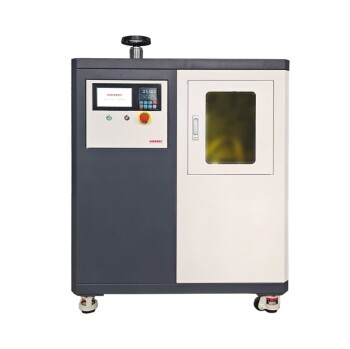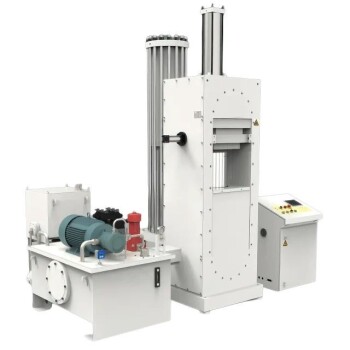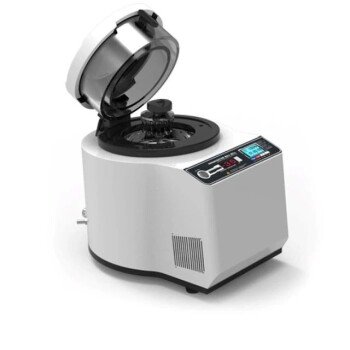At their core, ultra-low temperature (ULT) freezers are the silent guardians of modern biological research. They serve a central role in biobanks by providing the stable, cryopreservation environment required to preserve the molecular integrity of biological samples. By maintaining temperatures as low as -86°C, they effectively halt biological activity, preventing the degradation of invaluable materials like DNA, cells, and plasma for long-term storage and future use.
The primary role of a ULT freezer in a biobank is not merely refrigeration; it is to arrest biological time. By maintaining consistently low temperatures, these freezers halt the enzymatic and molecular processes that degrade samples, ensuring their scientific validity and value for years or even decades.
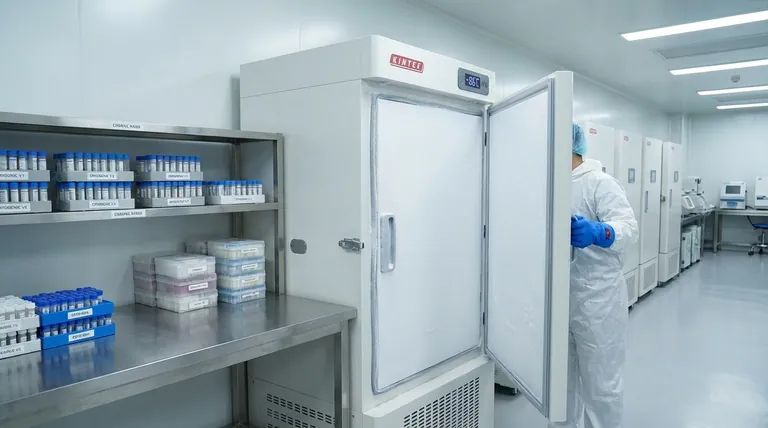
The Foundation of Sample Integrity
A biobank's value is directly tied to the quality of its samples. ULT freezers are the foundational technology for ensuring this quality from the moment a sample is stored.
Halting Molecular Degradation
Biological samples are vulnerable to degradation from enzymes and chemical reactions at normal temperatures. ULT freezers create an environment of extreme cold, typically -80°C to -86°C, which essentially stops this molecular activity. This is critical for preserving sensitive materials like RNA, DNA, proteins, and cell extracts.
Ensuring Long-Term Viability
The primary purpose of a biobank is to store samples for future research, which may occur years after the initial collection. ULT freezers make this possible by keeping samples in a state of suspended animation, ensuring their biological components remain unchanged and viable for future analysis.
Supporting a Diverse Range of Samples
Biobanks house a wide array of biological materials collected from patients, donors, and research participants. ULT freezers are versatile enough to properly store everything from plasma and tissue biopsies to viruses and engineered cell lines, making them indispensable for any repository.
Enabling Reliable and Reproducible Research
The quality of scientific discovery depends on the quality of the materials used. By preserving samples perfectly, ULT freezers directly impact the reliability and reproducibility of research outcomes.
Providing High-Quality Materials
Researchers rely on biobank samples to be accurate representations of their original state. Degraded samples can lead to flawed data and incorrect conclusions. ULT storage ensures that the genetic material and proteins within a sample remain stable and scientifically valid.
Facilitating Future Discovery
High-quality preserved samples allow researchers to apply new techniques and answer future scientific questions that may not have been conceived when the sample was collected. This capability accelerates discovery and maximizes the value of each sample.
Reducing Experimental Redundancy
With a reliable bank of well-preserved samples, researchers can access existing materials for new experiments. This avoids the costly and time-consuming process of collecting new samples and supports more efficient scientific progress.
Understanding the Operational Imperatives
While essential, integrating ULT freezers into a biobank operation involves more than just plugging them in. Success requires a focus on process and risk management.
Maintaining the Cold Chain
The integrity of a sample depends on an unbroken cold chain from collection to long-term storage. Any temperature fluctuation can compromise sample quality. This makes the freezer's performance and the processes around it critical for maintaining supply chain integrity.
The Need for Redundancy and Monitoring
A freezer failure can be catastrophic, leading to the irreversible loss of years of work and priceless samples. For this reason, biobanks often use ULT freezers for emergency backup storage and rely on sophisticated monitoring systems with alarms to prevent such disasters.
Supporting Regulatory Compliance
For biobanks involved in clinical trials or diagnostics, sample storage is subject to strict regulatory oversight. ULT freezers with robust temperature logging and validation features are essential for proving compliance and ensuring that samples are fit for use in medical applications.
Making the Right Choice for Your Biobank
Choosing and managing your ULT freezer infrastructure depends directly on the core mission of your biobank.
- If your primary focus is large-scale population studies: Prioritize freezers with high storage capacity, excellent energy efficiency, and robust remote monitoring systems to manage thousands of samples reliably.
- If your primary focus is supporting clinical trials: Emphasize ULT freezers with superior temperature uniformity and comprehensive data logging capabilities to meet strict regulatory compliance standards.
- If your primary focus is advanced cell therapy: Invest in systems that offer rapid temperature recovery after door openings to protect highly sensitive and often irreplaceable cell-based samples.
Ultimately, the ULT freezer is the engine that guarantees the long-term value and trustworthiness of your entire biorepository.
Summary Table:
| Key Function | Benefit to Biobanks |
|---|---|
| Halts Molecular Degradation | Preserves DNA, RNA, proteins, and cells for future use |
| Enables Long-Term Storage | Maintains sample viability for years or decades |
| Supports Diverse Samples | Stores plasma, tissues, viruses, and cell lines |
| Ensures Research Reproducibility | Provides high-quality, stable materials for reliable data |
| Aids Regulatory Compliance | Features data logging for clinical and diagnostic standards |
Ensure the Integrity of Your Invaluable Samples
Your biobank's credibility depends on the quality of its preserved samples. KINTEK specializes in providing reliable laboratory equipment, including ultra-low temperature freezers, to meet the precise demands of modern biorepositories.
Partner with KINTEK to:
- Protect Your Investment: Safeguard priceless biological collections with freezers designed for maximum temperature stability and recovery.
- Simplify Compliance: Utilize equipment with advanced monitoring and data logging features to effortlessly meet regulatory standards.
- Optimize Your Workflow: Our expertise in lab equipment helps you design a storage solution that enhances efficiency and security.
Don't leave your research to chance. Contact KINTEK today to discuss how our solutions can become the silent guardian of your biobank's mission.
Visual Guide
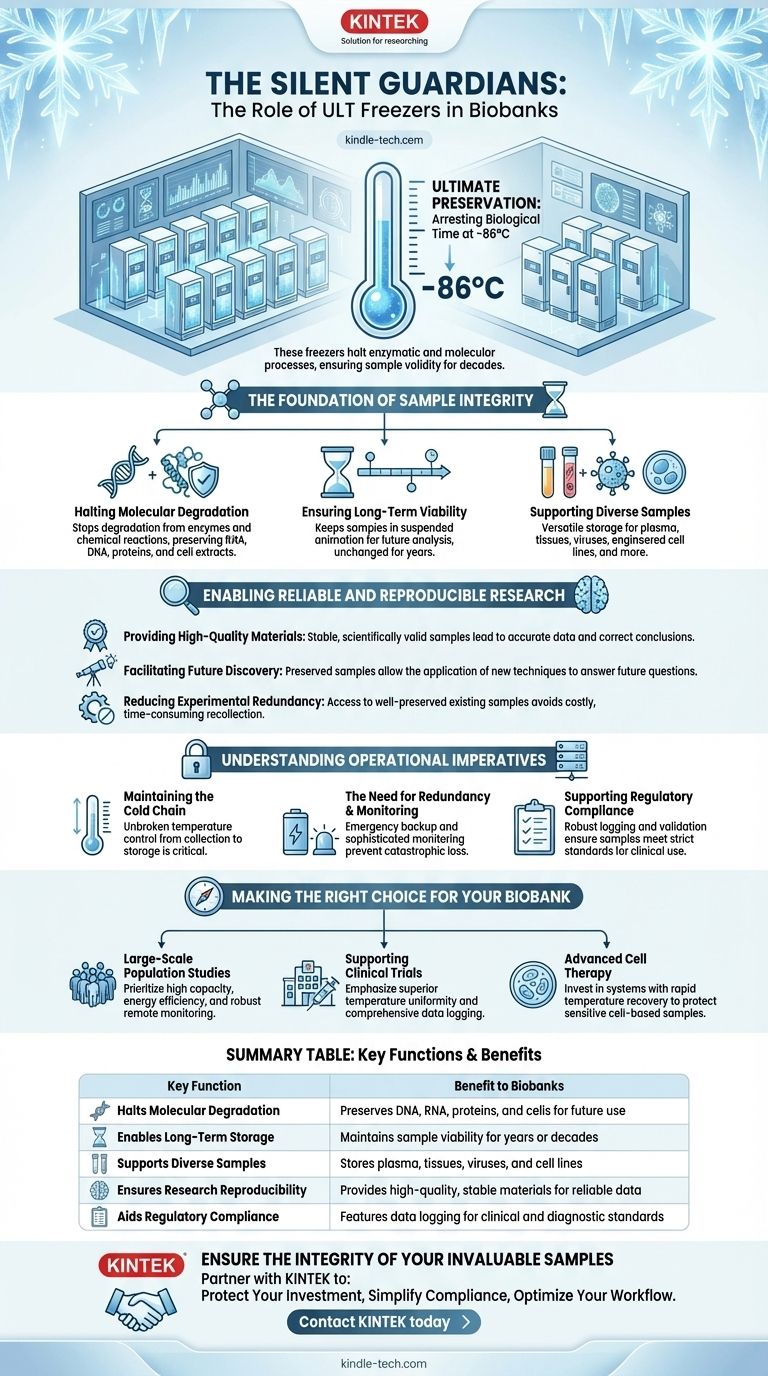
Related Products
- 508L Advanced Vertical Ultra Low Temperature Freezer for Critical Laboratory Storage
- 408L Advanced Vertical Laboratory Ultra Low Temperature Freezer for Critical Research Material Preservation
- 608L Essential Laboratory Ultra Low Temperature Freezer For Critical Sample Preservation
- 28L Compact Upright Ultra Low Temperature Freezer for Laboratory
- 708L Ultra Low Temperature Freezer High Performance Laboratory Freezer
People Also Ask
- What makes Ultra-Low Temperature freezers energy efficient? Key Design & Operational Strategies
- Where are ultra low temperature freezers commonly used? Essential for Labs, Hospitals, and Biotech
- What are ultra low temperature freezers used for? Preserving Critical Biological Samples for Decades
- What advantages do ultra-low temperature freezers offer? Ensure Long-Term Sample Integrity and Reliability
- How do Ultra-Low Temperature freezers ensure the integrity of microbiological samples? Maintain Stability for Critical Research














